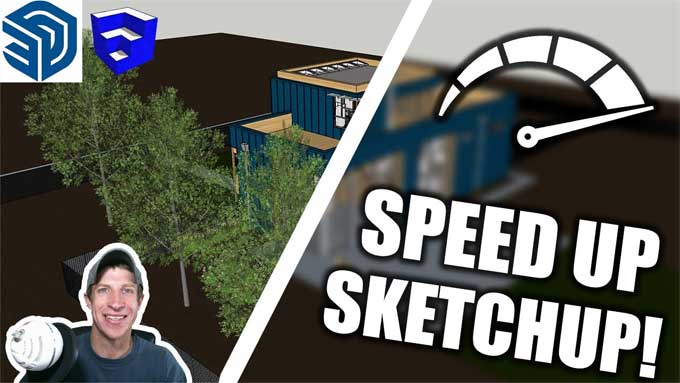Speed up your workflow and Performance in SketchUp: Five of the best tips to follow

SketchUp is one of the best apps for designing and is used for many other purposes. In SketchUp, productivity is crucial. The software provides a straightforward, user friendly method of producing a variety of items. SketchUp is among the quickest digital design tools available because of its simplicity. In a few minutes, you can have simple items on your screen.
It does not matter how much modeling experience you have or how you model, the way you model influences SketchUp's performance, and this article discusses how to create 3D models in a way that optimizes SketchUp's performance and workflow for you.
Increasing of performance
Checkup on your hardware steps: SketchUp is a pretty heavy specs app and requires your computer to have some decent specs to run well. SketchUp's performance is influenced by the RAM, processor speed, and graphics card on your computer.
Ensure that your computer meets or exceeds SketchUp's minimum system requirements if SketchUp is noticeably sluggish.
Make sure you have the latest version of SketchUp installed on your computer. Staying up-to-date with SketchUp updates will improve its performance. Your graphics card driver and the operating system often have similar issues. The SketchUp software update checker is available under the Help menu (Windows) and the Check Web for Updates option (Mac OS)
Choosing OpenGL and antialiasing preferences: A 3D rendering application like SketchUp uses OpenGL, which stands for Open Graphics Library. Graphics can be smoothed with anti-aliasing by eliminating jagged edges.
Having learned what OpenGL, anti-aliasing, and the OpenGL and anti-aliasing preferences are, you now have an idea of what these preferences do. SketchUp may render your model more quickly if you adjust a few OpenGL settings on your computer if your computer has performance issues with SketchUp.
You will need to select Window > Preferences (Microsoft Windows) or SketchUp > Preferences (Mac OS X) in order to access the OpenGL preferences. In the left-hand sidebar, you can select the OpenGL option by clicking on it.
Increasing the Workflow
You must follow some of these tips if you want to increase your overall workflow while using SketchUp.
Usage of Shortcuts: There are several shortcuts in SketchUp that can be assigned to different hotkeys. The tools of digital design software can be accessed quickly with these shortcuts. The key to speeding up your workflow is understanding what they are. The time you save each time you access a tool may only be a few seconds.
Changing the style of the display: In the long run, these seconds will amount to many minutes of time saved when we work on complex models.
There are several options activated by default in the default SketchUp view that can slow your progress. There are two settings that are particularly important: Face Style and Shadow. By selecting View from the menu, you will be able to access both options. To achieve the best results, uncheck the Shadows setting and choose Shaded for your Face Style.
Usage of Layers: It is easier to work on complex models when you use layers. It is possible to create your broad model on a base layer and separate your detailed objects onto a different layers. As a result, you have the option of toggling on and off individual objects as needed.
Detail objects can be worked on in their own layer and turned off again when working on the base model.
Spot out the faces that are flipped: You will have to do a lot more work if you fail to catch a flipped face before it is too late. In some situations, SketchUp has a nasty tendency to create faces that are flipped when they should be upright.
In order to avoid this problem, you will need to use a different setting for your face style. If you have applied a texture to your face, you can use the Monochrome Face Style to point out faces that have been flipped.
A grey color is used for the default side, and a blue color is used for the other side. You will know that there is a flip in your face when you see a bit of blue in the middle of a sea of gray.
Choose every component wisely: Although this is fantastic, anyone who has ever used digital design tools will tell you that it can lead to issues. If a complicated component is changed and the change does not fit with the rest of the model, it can cause problems in one of the models that use it.
Although this is excellent, anyone who has ever used digital design tools will tell you that it can lead to issues. If a complicated component is changed and the change does not fit with the rest of the model, it can cause problems in one of the models that use it.
To learn more, watch the following video tutorial.
Video Source: TheSketchUpEssentials
Grouping the layers: In general, it is a good rule of thumb to the group before creating a layer, as this will prevent confusion.
The benefit of this method is that you can separate your geometry from your grouped objects while ensuring that the geometry of the base objects stays on Layer0.



